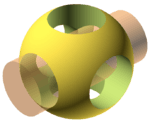OpenSCAD
 | |
| Developer(s) | Marius Kintel, Clifford Wolf |
|---|---|
| Stable release | 2015.03 / 10 March 2015 |
| Written in | C++ (Qt)[1] |
| Operating system | Windows, Linux, OS X, FreeBSD, OpenBSD |
| Type | CAD |
| License | GNU General Public License |
| Website |
www |
OpenSCAD is a free software application for creating solid 3D CAD objects. It is not an interactive modeler, but rather a 3D-compiler based on a textual description language. An OpenSCAD document specifies geometric primitives and defines how they are modified and manipulated to render a 3D model. OpenSCAD is available for Windows, Linux and OS X. It does constructive solid geometry (CSG).
As of 2015, it uses Computational Geometry Algorithms Library (CGAL) as the basic CSG engine, which along with other libraries takes care of details such as intersection, difference and Minkowski sums. The results can be rendered into 2D DXF or SVG files, 3D AMF, OFF, STL files, or PNG images. For fast previewing of models using z-buffering, OpenSCAD employs OpenCSG and OpenGL. In contrast, CGAL is used for full 3D geometry rendering that, as with other CSG geometry engines, can sometimes take several minutes or hours to complete.
OpenSCAD allows a designer to create accurate 3D models and parametric designs that can be easily adjusted by changing the parameters.[2]
Compared to most other CAD file formats, which are not easily human-readable, OpenSCAD documents behave like open source software. Because of their textual nature, it is much easier for people to distribute CAD drawings as OpenSCAD documents, independently make different incremental improvements, and then merge all the improved CAD drawings together as a document that includes all the improvements.[3]
As such, OpenSCAD is a non-visual, programmer-oriented solid modeling tool,[4] and has been recommended as an entry-level CAD tool for designing open source hardware such as scientific tools for research and education.[5]
See also
- List of computer-aided design editors for architecture, engineering and construction
- PLaSM is another open source scripting language for creating 3D objects
References
- ↑ https://github.com/openscad/openscad/blob/master/README.md#building-openscad
- ↑ Evans, Brian (2012), Practical 3D Printers: The Science and Art of 3D Printing, Apress, p. 113, ISBN 9781430243922
- ↑ Rückert, Ulrich; Sitte, Joaquin; Werner, Felix (2012), Advances in Autonomous Mini Robots: Proceedings of the 6-th AMiRE Symposium, p. 61,
This feature is enhanced by the fact that the mechanical parts are OpenSCAD ASCII scripts, like any other software. Consequently, they behave like open source software and can be distributed and shared in a similar way.
- ↑ Pettis, Bre; France, Anna Kaziunas; Shergill, Jay (2012), Getting Started with MakerBot, O'Reilly Media, Inc., p. 131, ISBN 9781449338657
- ↑ Pearce, Joshua M. (2014), Open-Source Lab: How to Build Your Own Hardware and Reduce Research Costs, Elsevier
External links
- Official website
-
 OpenSCAD User Manual at Wikibooks
OpenSCAD User Manual at Wikibooks -
 Media related to OpenSCAD at Wikimedia Commons
Media related to OpenSCAD at Wikimedia Commons - OpenSCAD page on Shapeoko wiki — includes links to supporting utilities, special purpose tools (such as a screw generator) and includes an example of creating a Machinist's diamond, circle, square milling test as a parameterized file suitable for re-creating at any desired size.
- Videos on the basics of modeling with OpenSCAD
| ||||||||||||||||||
| ||||||||||||||||||||||||||||||